Every year when the air turns crisp and leaves start falling, one ingredient comes back to center stage in my kitchen: pumpkin. It’s more than just the round orange lantern of Halloween—it’s a canvas for creativity and a reminder of the deep connection between food, culture, and seasonality. Pumpkin is the kind of ingredient that carries both nostalgia and refinement: we remember childhood soups or pies, but in the hands of a chef, it can become the foundation of veloutés layered with mushrooms, creamy risottos, or elegant desserts.
I often say that cooking with pumpkin is about balance: its natural sweetness needs to be highlighted but also contrasted. Pairing it with spices such as nutmeg, cinnamon, or even a delicate touch of vanilla creates warmth, while sharp cheeses or smoky meats bring depth. The beauty of pumpkin is in its adaptability—it can be rustic and comforting, or sophisticated and surprising.
In this article, I’ll share not just recipes but also my professional insights into buying, preparing, cooking, and elevating pumpkin. Along the way, I’ll guide you through its botanical roots, how it differs from close cousins like butternut squash or potimarron, and why it deserves a place at the table from October through the holidays. Think of this as both a seasonal guide and a culinary journey into one of autumn’s most versatile gifts.
Pumpkin, its cousins, and their differences
Understanding pumpkin means first placing it in its family. Botanically, pumpkin belongs to the Cucurbita genus, specifically Cucurbita pepo. Native to the Americas, it arrived in Europe in the sixteenth century and quickly became a staple, not only for its size and durability but also for its culinary and medicinal virtues. What makes pumpkin fascinating for a chef is that it is often confused with other squashes, and yet the choice of variety can completely change the texture, sweetness, and overall character of a dish.
Take the classic pumpkin (citrouille): round, ribbed, often large, with a firm and slightly fibrous flesh. Its sweetness is subtle, which makes it ideal for soups or gratins where you can layer other flavors around it. Compare this with butternut squash, whose creamy texture and nutty flavor shine in dishes like Roasted Butternut Squash Lasagna or even in simple purées. Butternut is easier to peel and cut, which is why I also prepared a tutorial on How To Cut A Butternut Squash.
Then there’s potimarron, smaller, with a chestnut-like flavor and a skin that can be cooked and eaten. For chefs, this means less waste and a richer earthy note, perfect for veloutés or roasting. Finally, the giant jack-o’-lantern varieties may not be the most flavorful but remain iconic for presentation and festive traditions.
Knowing these differences is essential: I wouldn’t use a Halloween carving pumpkin for a refined dessert, but I might happily use butternut for a cake or potimarron for a risotto. Each cousin has its place, and as a chef, I choose depending on the texture, sweetness, and culinary goal I want to achieve.
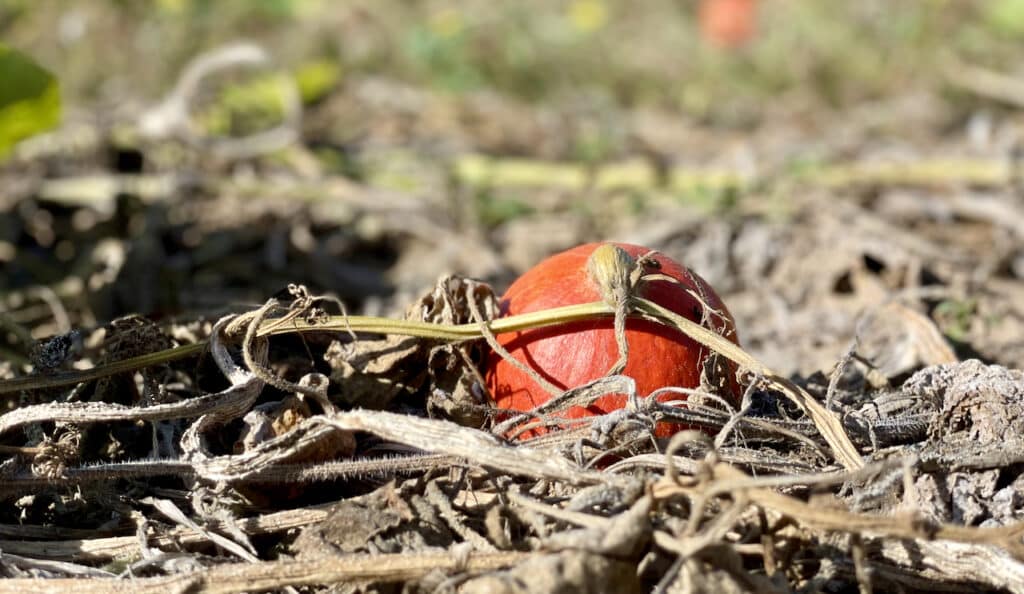
Pumpkin and culinary traditions
Pumpkin isn’t just food; it’s culture. Every autumn, it appears not only on our plates but also in our stories, celebrations, and rituals. As chefs, we cook with ingredients that carry memories, and pumpkin is one of those that bridges childhood nostalgia with refined gastronomy.
The most iconic image, of course, is Halloween. Pumpkins carved into jack-o’-lanterns are now global symbols, but originally this tradition came from Ireland, where turnips were hollowed out and lit with candles. When Irish immigrants reached America, they discovered that pumpkins were larger, easier to carve, and far more striking. The result was a culinary and cultural shift: pumpkins became the face of Halloween, while their flesh—once discarded—started being turned into soups and pies.
In the United States, pumpkin also holds pride of place during Thanksgiving. The feast is incomplete without pumpkin pie, which has become a symbol of comfort and abundance. I’ve shared my guide on How to prepare a perfect Thanksgiving feast , where pumpkin often plays a central role, whether in savory gratins, veloutés, or sweet pies. The ritual of baking pumpkin pie isn’t just about dessert; it’s about sharing tradition at the table.
Beyond these celebrations, pumpkin traditions are diverse. In Central Europe, it’s baked into breads or simmered in soups. In Italy, pumpkin-filled ravioli are a delicacy from Lombardy, while in Japan, kabocha (a cousin of pumpkin) is simmered with soy and mirin, highlighting its natural sweetness.
For me, cooking pumpkin is about honoring these traditions while also reimagining them. Whether I’m preparing a rustic Pumpkin Cake or my artistic Pumpkin Trompe l’Oeil recipe, I’m part of a lineage of chefs and families who have celebrated this vegetable for centuries.

Buying and storing pumpkin like a pro
One of the first lesson is that great cooking begins with choosing the right product. With pumpkin, there are a few simple but crucial details that make all the difference. When I shop for fresh pumpkin, I look for a firm, heavy fruit with a matte skin and no soft spots. The stem should still be intact and dry, almost cork-like—this is a sign of proper harvesting and better storage potential.
If you’re buying for soups or gratins, medium-sized pumpkins often have better flavor concentration than oversized ones bred for decoration. For desserts, I prefer sweeter, denser-fleshed varieties such as butternut or smaller culinary pumpkins. This choice ensures a smooth purée that blends harmoniously with spices.
Storage is another overlooked but vital step. A whole pumpkin will keep for weeks if stored at 10–15°C, away from direct light and moisture. Don’t leave it in a warm kitchen corner—it will deteriorate quickly. Once cut, wrap the pieces tightly and refrigerate; they’ll keep for 3–5 days. If you want to freeze pumpkin, blanch the cubes for a few minutes in steam or boiling water before cooling and freezing. This preserves color, texture, and nutritional value.
Finally, don’t forget the seeds. Cleaned and roasted, they’re a chef’s secret weapon for crunch and garnish, and pumpkin seed oil—deep green and nutty—is best drizzled cold over salads or roasted vegetables. These details transform pumpkin from a humble vegetable into a refined, versatile ingredient ready for any professional kitchen.
Preparation and cooking techniques
Pumpkin can intimidate home cooks, but once you master preparation, you unlock endless possibilities. The first step is cutting: a sharp chef’s knife and a stable board are essential. Always slice off a thin piece at the base so the pumpkin sits flat before cutting into wedges. Scoop out the seeds and save them—they’re too valuable to waste. For tough varieties, I sometimes roast the pumpkin halves briefly to soften the skin before peeling.
The method of cooking determines the final texture and flavor profile. Roasting concentrates sugars and brings caramelization—perfect for gratins or pies like a creative Pumpkin Gratin. Steaming is lighter, keeping the color vibrant, ideal for veloutés such as delicious Pumpkin velouté. Boiling is quick but can dilute flavor, so I use it only if I plan to enrich the dish with stock or cream.
For savory dishes, I often cube and sauté pumpkin in olive oil with garlic, thyme, or sage before adding it to risottos or pasta fillings. In Japanese cuisine, pumpkin is simmered with dashi and soy sauce, creating a delicate sweet-salty balance—a technique I adapt in my own cooking to bring subtlety to side dishes.
When it comes to desserts, the smoothness of the purée is key. I always pass pumpkin through a fine sieve after blending; this extra step gives silkiness to pies, cakes, or custards (like pumpkin pie recipe , or pumpkin flan). For professionals, consistency in texture is what elevates pumpkin from rustic to gastronomic.
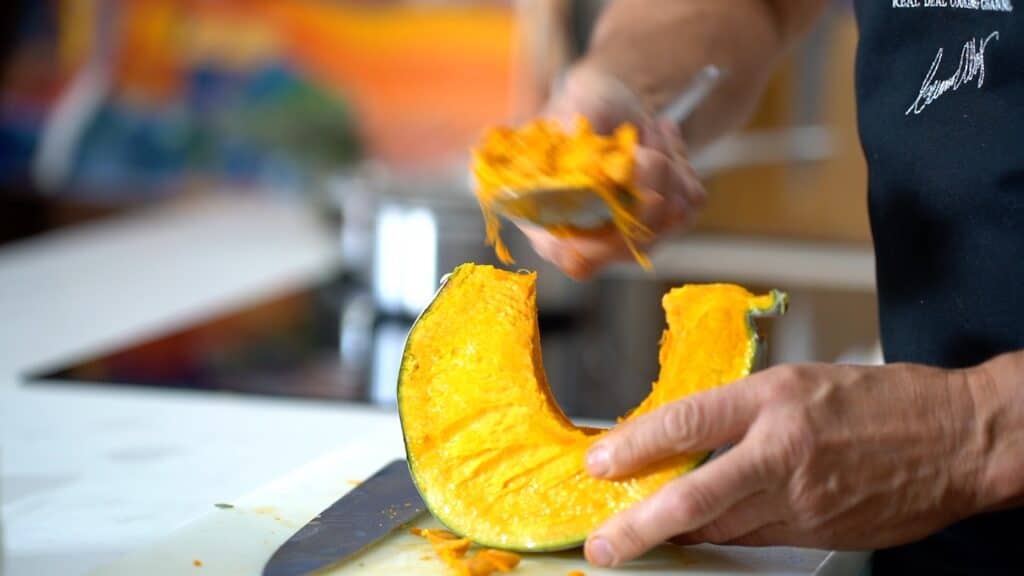
Pumpkin in savory cooking: entrées and veloutés
Pumpkin shines in appetizers and soups, where its natural sweetness sets the stage for contrasting flavors. A well-crafted pumpkin velouté is never just about puréeing cooked cubes with cream; it’s about layering flavors. I often start with a sweat of shallots or onions, sometimes adding a touch of carrot or celery for aromatic depth. Once the pumpkin is tender, I blend everything until silky, then pass it through a fine chinois for a professional finish.
The beauty of pumpkin velouté is in the garnish. Instead of serving it plain, think of contrast: sautéed girolles, crispy lardons, roasted pumpkin seeds, or even a swirl of crème fraîche infused with herbs. A drizzle of pumpkin seed oil adds nuttiness and elegance. My Pumpkin velouté version recipe is one example of how simple ingredients, handled with precision, create a dish worthy of both a family table and a restaurant menu.
Another trick is to play with spice. Nutmeg, cinnamon, or even ginger can give the soup a gentle warmth, while chili brings brightness and energy. Don’t forget texture: thin slices of oven-dried pumpkin or parmesan crisps make wonderful additions. In professional plating, I see velouté not as a bowl of soup, but as a canvas—one where autumn’s colors and aromas can be expressed with artistry.
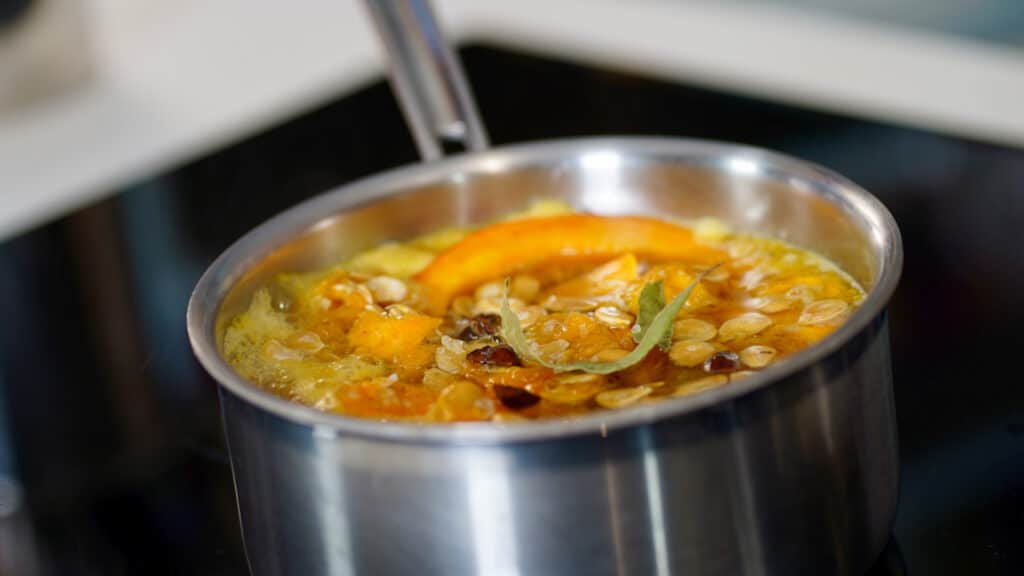
Pumpkin in savory cooking: main courses
For main dishes, pumpkin becomes more than a side—it’s a star. Its texture and sweetness allow it to play alongside proteins or even replace them in vegetarian preparations. I often roast wedges of pumpkin with garlic, sage, and olive oil, then use them as a base for grain bowls or as layers in a gratin. My pumpkin gratin demonstrates how caramelization elevates the vegetable from comforting to refined.
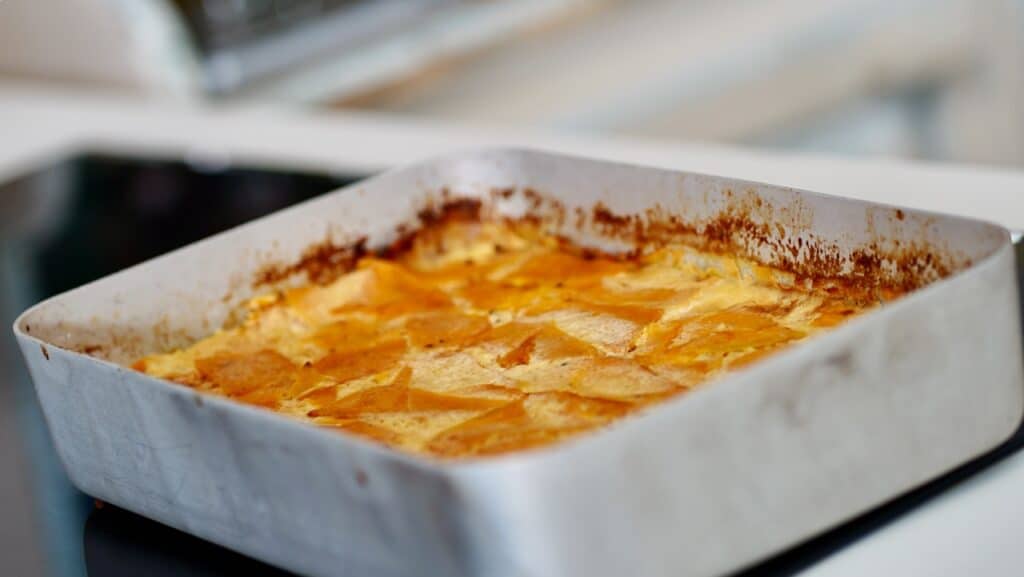
Risotto is another ideal playground for pumpkin. The starch of arborio rice binds beautifully with pumpkin’s smooth purée, creating a creamy base without excessive cream. In my Pumpkin Risotto recipe, I emphasize balance: the sweetness of pumpkin offset by parmesan’s umami and perhaps the crunch of toasted seeds.
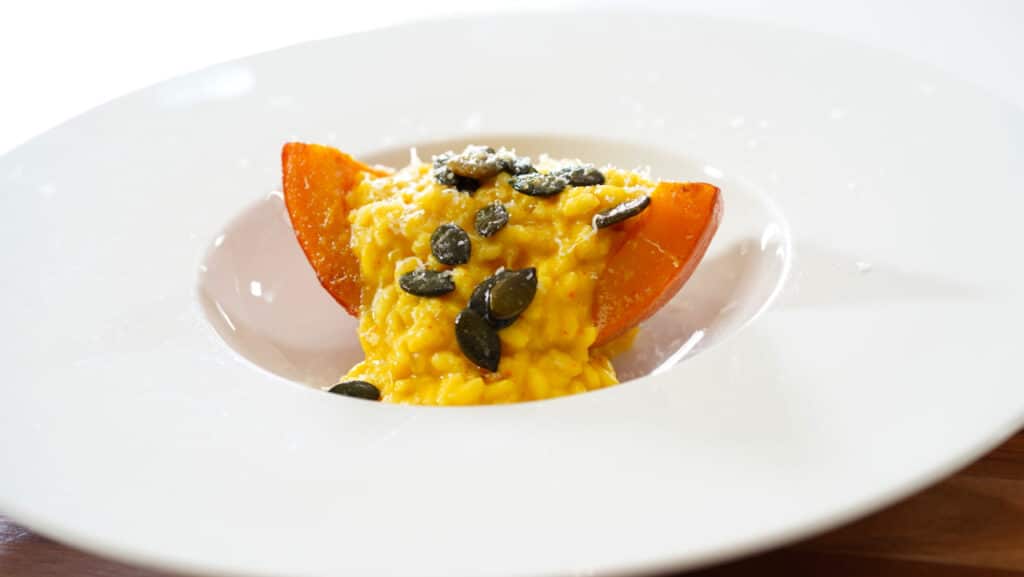
Pumpkin also marries well with poultry. I often serve it alongside dishes such as Chicken Ballotine, where its earthy sweetness enhances the delicate meat. For vegetarians, stuffed pumpkin halves with quinoa or lentils make complete, nourishing meals.
For inspiration, look at how butternut squash transforms in Roasted Butternut Squash Lasagna —pumpkin works equally well, layered with béchamel, pasta, and cheese. This is the kind of dish that bridges rustic comfort and elegant dining, a reminder that pumpkin isn’t just seasonal decoration but a foundation for serious cooking.
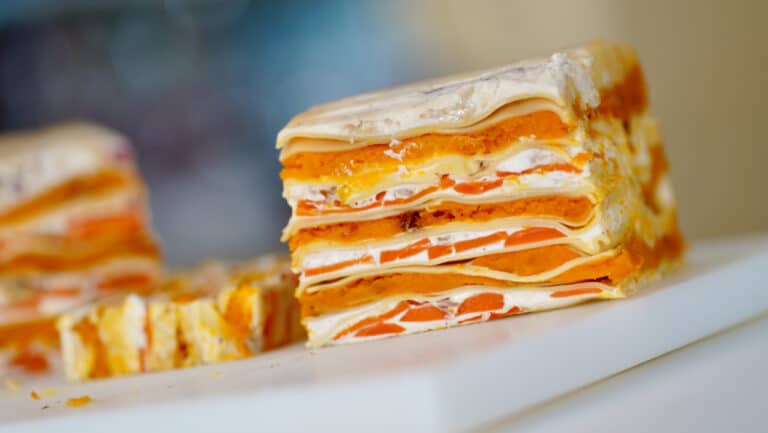
Pumpkin in sweet cooking: traditional desserts
Pumpkin may surprise those who only know it from soups, but in pastry, it becomes a true revelation. Its natural sweetness, silky texture, and subtle earthy notes create a base that marries beautifully with spices like cinnamon, nutmeg, ginger, and vanilla. This is why pumpkin pie has become such a cultural icon of fall, especially at Thanksgiving.
When I prepare a classic Pumpkin Pie, I focus on precision. The crust should be buttery and crisp, never soggy. Blind-baking is essential, and brushing the shell with egg white before filling helps create a barrier. The filling itself must be smooth, custard-like, with just enough spices to enhance the pumpkin without overwhelming it. Over-spicing is the most common mistake I see in home kitchens.
Variations keep the tradition alive while refreshing it. My Chocolate Pumpkin Pie layers cocoa’s richness over pumpkin’s natural sweetness, while the Healthy Pumpkin Pie shows how to lighten the dessert with less sugar and cream, without sacrificing indulgence. For those who appreciate heritage recipes, pumpkin custards, flans, or even puddings carry the same warm, autumnal feeling.
To me, pumpkin in desserts is about comfort—but professional technique makes it elegant. Sieving the purée for silkiness, balancing the spices, and achieving a glossy, uncracked custard are the small details that elevate pumpkin desserts from homemade to gastronomic.
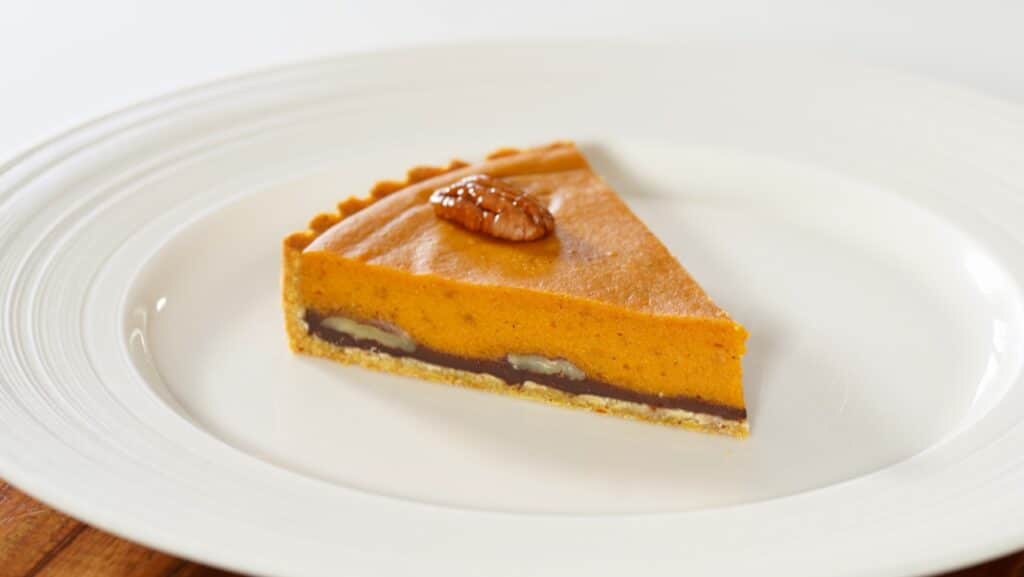
Pumpkin in sweet cooking: creative expressions
While traditional pies and cakes are beautiful, pumpkin invites creativity in modern pastry. I love challenging myself with trompe-l’œil presentations: as previously mentioned my Pumpkin Trompe l’Oeil for example transforms the humble vegetable into an artistic statement, surprising guests both visually and in taste. Here, pumpkin isn’t just an ingredient—it becomes storytelling on the plate.
Classic French techniques also adapt beautifully. Pumpkin Creme Brulee is a personal favorite, where pumpkin purée enriches the custard base, adding depth to the caramelized top. The result is familiar yet innovative, a bridge between rustic fall flavors and refined French patisserie.
For more playful desserts, I recommend the Giant Pumpkin Chocolate Cookies recipe. Here, pumpkin adds moisture and subtle flavor, creating a chewy, indulgent cookie perfect for the season. Similarly, Pumpkin Cake brings structure and spice into harmony, especially when paired with a tangy frosting.
Cross-pollination with pumpkin’s cousins also sparks ideas. For example Muffins with Butternut prove that sweet squashes adapt seamlessly to baking, giving a moist crumb and rich flavor. I encourage experimentation: pumpkin mousse layered with chocolate, semifreddo perfumed with spice, or even ice cream for a sophisticated fall menu.
The key is always the same: treat pumpkin with respect as a delicate base, not a blunt sweetener. By balancing it with texture (crisp pastry, caramelized sugar, crunchy seeds) and complexity (vanilla, citrus zest, dark chocolate), pumpkin desserts can be as refined and exciting as any classic pâtisserie creation.

Pairings and culinary creativity with pumpkin
One of the most rewarding aspects of cooking with pumpkin is discovering how well it pairs with other ingredients. As a chef, I see pumpkin as a neutral canvas with natural sweetness and earthiness—it wants to be contrasted, balanced, or elevated. Let me share some of the combinations that consistently bring out its best qualities.
Spices and aromatics. Pumpkin feels incomplete without spice. Nutmeg, cinnamon, and cloves create warmth, while ginger or chili add vibrancy. Vanilla, often misunderstood, can be a perfect companion; it rounds out pumpkin’s sweetness without overpowering it.
Cheeses and dairy. Sharp, salty cheeses like parmesan, pecorino, or aged goat cheese cut through pumpkin’s sweetness, especially in gratins or risottos. Cream, mascarpone, or crème fraîche highlight its silky side, ideal in veloutés or pies.
Proteins. Pumpkin pairs naturally with poultry or pork, where its sweetness complements savory richness. I often serve it alongside refined preparations like Chicken Ballotine . For vegetarians, pumpkin becomes the “meaty” component of the dish, particularly when roasted or stuffed with grains like described on my How To Cook Quinoa Correctly guide.
Textures and finishes. Seeds are the chef’s secret weapon. Roasted with spices, they bring crunch and a nutty counterpoint to pumpkin’s softness. Pumpkin seed oil, used cold, adds depth and elegance to salads or plated appetizers.
Plating ideas. Think of contrast: a bright orange velouté garnished with green herbs and white cream, a pumpkin dessert paired with dark chocolate for dramatic effect, or trompe-l’œil presentations like my Pumpkin Trompe l’Oeil recipe where surprise becomes part of the experience.
For me, pumpkin is about storytelling: each dish tells the tale of autumn, warmth, and comfort, but also of refinement and technique. Pair it thoughtfully, and it transforms from humble to unforgettable.
Nutrition and health benefits of pumpkin
As chefs, we focus on flavor and presentation, but I also believe in respecting the nutritional value of the ingredients I work with. Pumpkin is not only versatile and delicious—it’s also a powerhouse of health benefits that make it worth celebrating on every level.
First, pumpkin is rich in carotenoids such as beta-carotene and lutein. These antioxidants give the flesh its vivid orange color and play a role in protecting vision and supporting the immune system. A 2020 study even linked higher blood levels of carotenoids and vitamin C with a reduced risk of type 2 diabetes. From a practical perspective, this means that incorporating pumpkin into everyday meals isn’t just seasonal—it’s a long-term investment in well-being.
The seeds are another treasure. Traditionally used in different parts of the world for urinary and digestive health, they remain relevant today. In Germany, preparations based on pumpkin seeds are still used to ease bladder irritation and mild prostate issues. Nutritionally, the seeds are loaded with zinc, unsaturated fatty acids, and phytosterols—nutrients that support cardiovascular health. Roasting them with spices is one of my favorite ways to transform them into both garnish and snack.
Pumpkin also provides a good dose of complex carbohydrates and B vitamins, which make it nourishing and comforting. This is why pumpkin dishes feel satisfying without being heavy. For those who want to cook lighter, recipes like my Healthy Pumpkin Pie recipe show how to highlight pumpkin’s natural nutrition while keeping indulgence intact.
For me, the real value of pumpkin lies in this duality: it nourishes both the body and the imagination. Cooking with it means serving food that’s as beneficial as it is beautiful.
